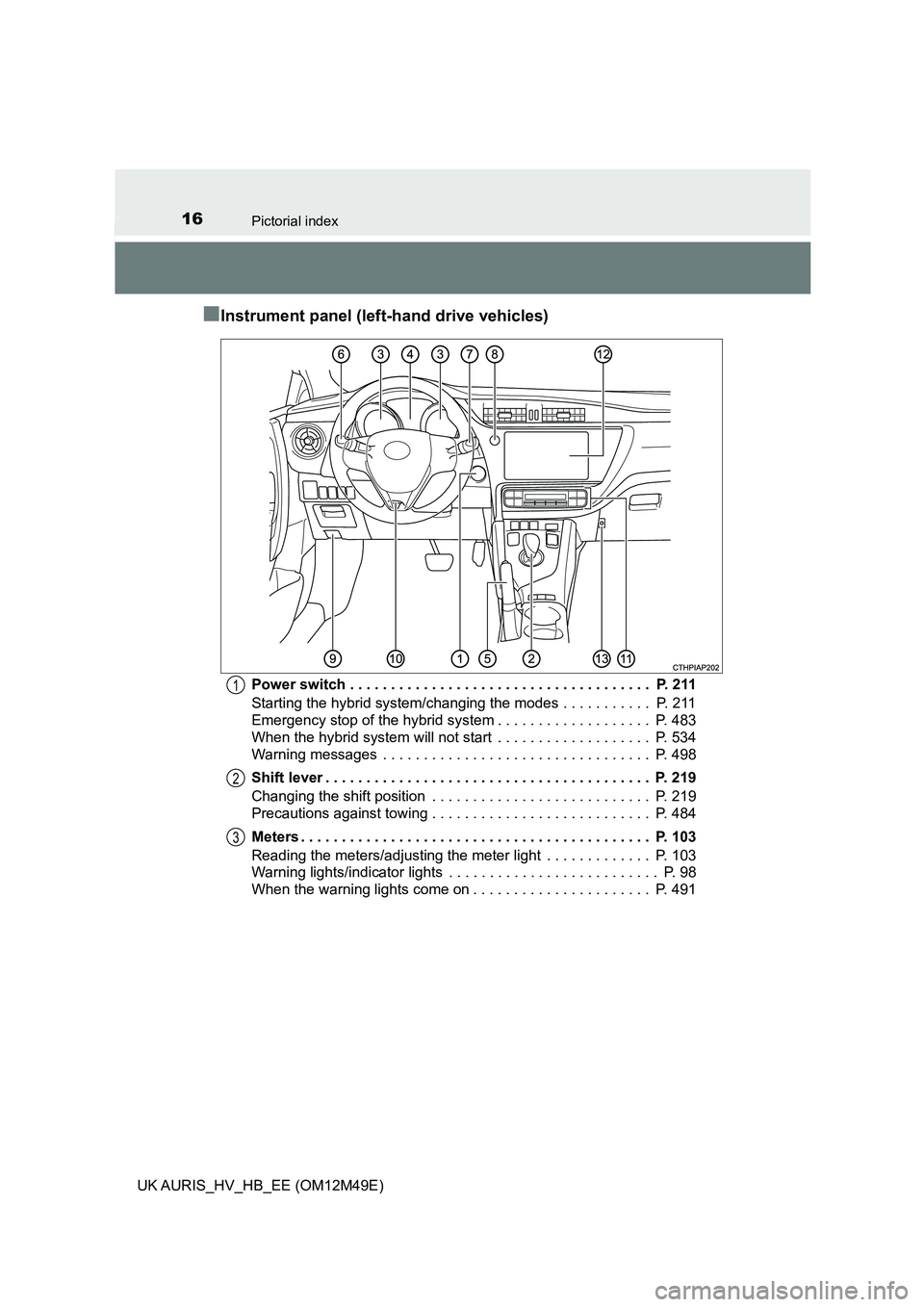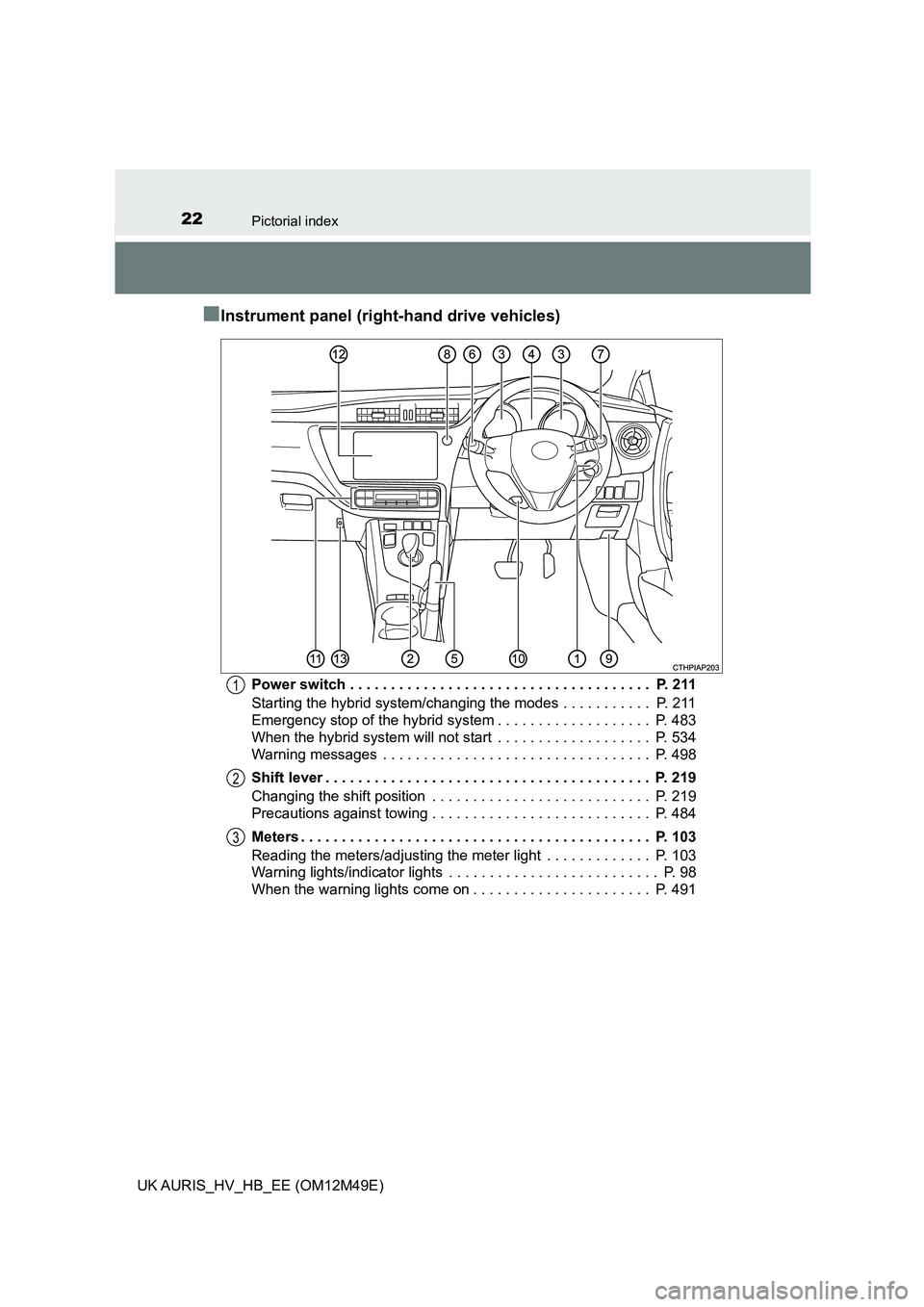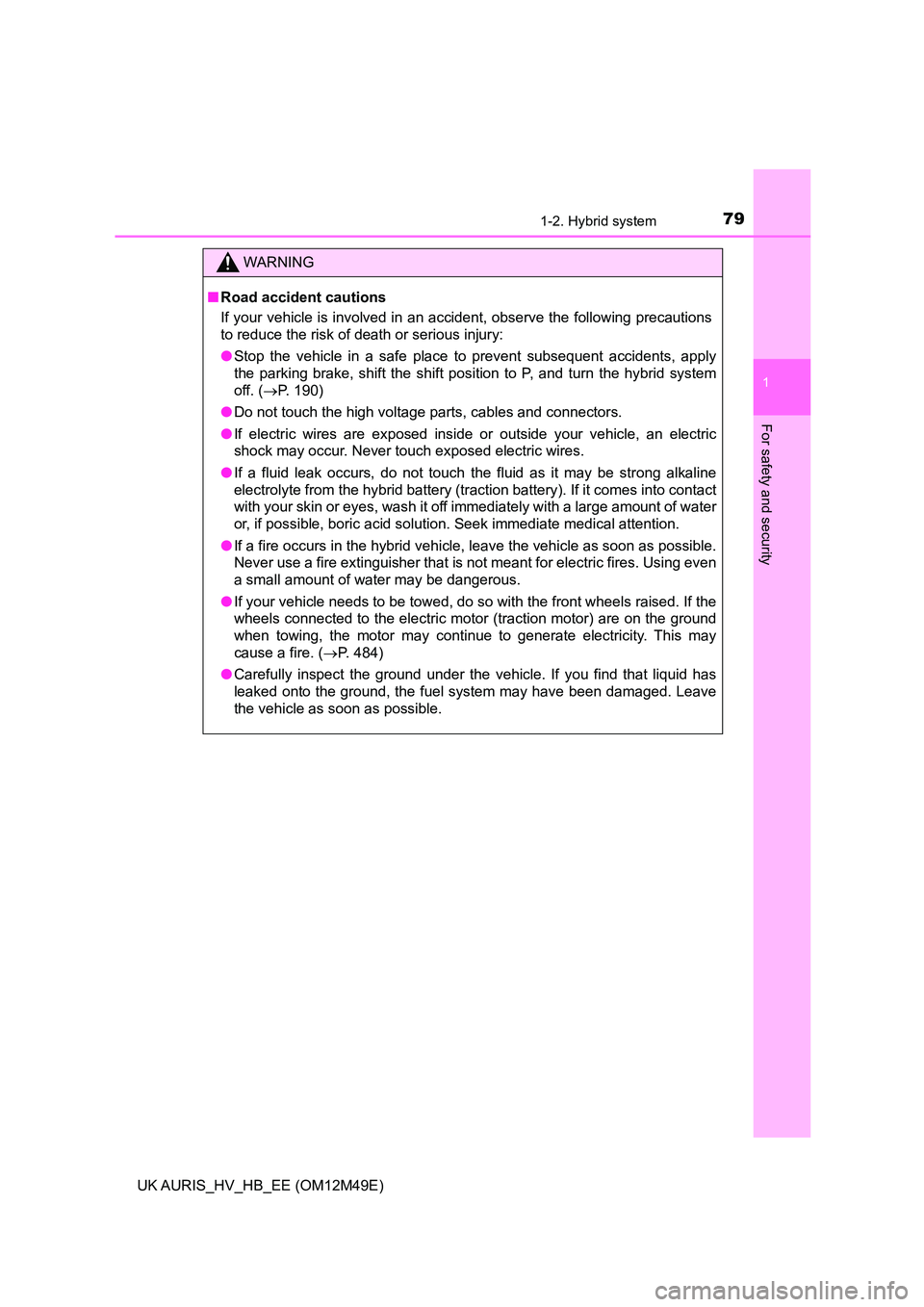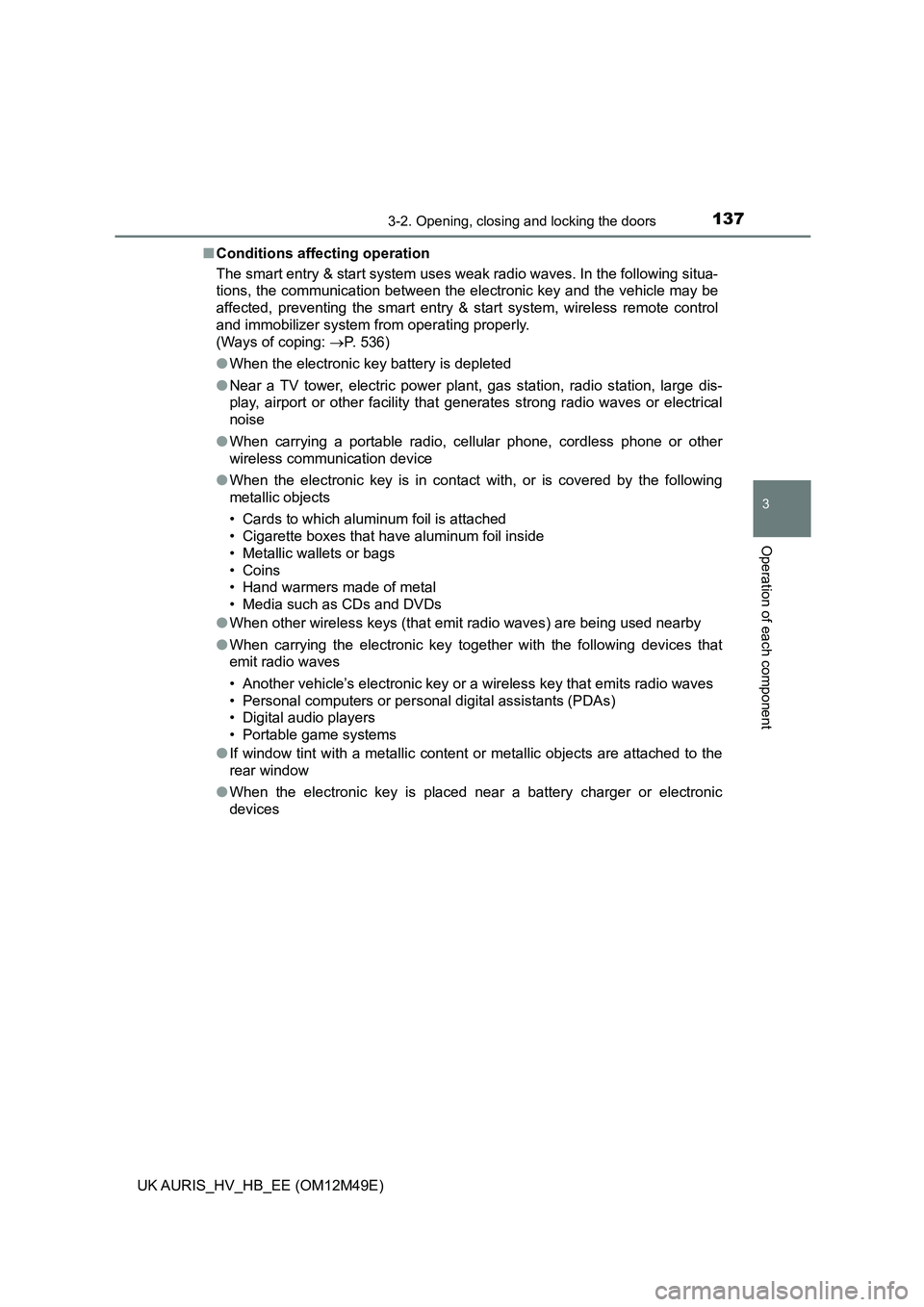2018 TOYOTA AURIS tow
[x] Cancel search: towPage 3 of 592

3
1
9
8
7
5
4
3
2
UK AURIS_HV_HB_EE (OM12M49E)
6
4-1. Before driving
Driving the vehicle .............190
Cargo and luggage ............200
Trailer towing .....................201
4-2. Driving procedures
Power (ignition) switch .......211
EV drive mode ...................217
Hybrid transmission ...........219
Turn signal lever ................227
Parking brake.....................228
4-3. Operating the lights
and wipers
Headlight switch.................229
Fog light switch ..................235
Windshield wipers
and washer ......................237
Rear window wiper
and washer ......................241
4-4. Refueling
Opening the fuel tank
cap ...................................243
4-5. Toyota Safety Sense
Toyota Safety Sense ......... 246
PCS
(Pre-Crash Safety
system) ........................... 252
LDA
(Lane Departure Alert) .... 265
Automatic High Beam ....... 270
RSA (Road Sign Assist) .... 274
4-6. Using the driving
support systems
Cruise control .................... 280
Toyota parking
assist-sensor ................... 284
Simple-IPA
(Simple-Intelligent
Parking Assist) ................ 291
Driving assist systems....... 305
4-7. Driving tips
Hybrid vehicle driving
tips .................................. 311
Winter driving tips.............. 314
4Driving
Page 6 of 592

TABLE OF CONTENTS6
UK AURIS_HV_HB_EE (OM12M49E)
7-1. Maintenance and care
Cleaning and protecting
the vehicle exterior ..........412
Cleaning and protecting
the vehicle interior ...........416
7-2. Maintenance
Maintenance
requirements....................419
7-3. Do-it-yourself
maintenance
Do-it-yourself service
precautions ......................422
Hood ..................................424
Positioning a floor jack .......426
Engine compartment..........427
12-volt battery ....................434
Tires ...................................439
Tire inflation pressure ........453
Wheels ...............................455
Air conditioning filter ..........457
Electronic key battery ........459
Checking and replacing
fuses ................................462
Light bulbs .........................467
8-1. Essential information
Emergency flashers .......... 482
If your vehicle has
to be stopped
in an emergency ............. 483
8-2. Steps to take
in an emergency
If your vehicle needs
to be towed ..................... 484
If you think something
is wrong........................... 490
If a warning light turns on
or a warning buzzer
sounds ............................ 491
If a warning message
is displayed ..................... 498
If you have a flat tire
(vehicles with
a spare tire) ..................... 507
If you have a flat tire
(vehicles with
an emergency tire
puncture repair kit) .......... 519
If the hybrid system will
not start ........................... 534
If the electronic key
does not operate
properly ........................... 536
If the 12-volt battery
is discharged ................... 539
If your vehicle
overheats ........................ 544
If the vehicle becomes
stuck................................ 549
7Maintenance and care8When trouble arises
Page 16 of 592

16Pictorial index
UK AURIS_HV_HB_EE (OM12M49E)
■Instrument panel (left-hand drive vehicles)
Power switch . . . . . . . . . . . . . . . . . . . . . . . . . . . . . . . . . . . . . P. 211
Starting the hybrid system/changing the modes . . . . . . . . . . . P. 211
Emergency stop of the hybrid system . . . . . . . . . . . . . . . . . . . P. 483
When the hybrid system will not start . . . . . . . . . . . . . . . . . . . P. 534
Warning messages . . . . . . . . . . . . . . . . . . . . . . . . . . . . . . . . . P. 498
Shift lever . . . . . . . . . . . . . . . . . . . . . . . . . . . . . . . . . . . . . . . . P. 219
Changing the shift position . . . . . . . . . . . . . . . . . . . . . . . . . . . P. 219
Precautions against towing . . . . . . . . . . . . . . . . . . . . . . . . . . . P. 484
Meters . . . . . . . . . . . . . . . . . . . . . . . . . . . . . . . . . . . . . . . . . . . P. 103
Reading the meters/adjusting the meter light . . . . . . . . . . . . . P. 103
Warning lights/indicator lights . . . . . . . . . . . . . . . . . . . . . . . . . . P. 98
When the warning lights come on . . . . . . . . . . . . . . . . . . . . . . P. 491
1
2
3
Page 22 of 592

22Pictorial index
UK AURIS_HV_HB_EE (OM12M49E)
■Instrument panel (right-hand drive vehicles)
Power switch . . . . . . . . . . . . . . . . . . . . . . . . . . . . . . . . . . . . . P. 211
Starting the hybrid system/changing the modes . . . . . . . . . . . P. 211
Emergency stop of the hybrid system . . . . . . . . . . . . . . . . . . . P. 483
When the hybrid system will not start . . . . . . . . . . . . . . . . . . . P. 534
Warning messages . . . . . . . . . . . . . . . . . . . . . . . . . . . . . . . . . P. 498
Shift lever . . . . . . . . . . . . . . . . . . . . . . . . . . . . . . . . . . . . . . . . P. 219
Changing the shift position . . . . . . . . . . . . . . . . . . . . . . . . . . . P. 219
Precautions against towing . . . . . . . . . . . . . . . . . . . . . . . . . . . P. 484
Meters . . . . . . . . . . . . . . . . . . . . . . . . . . . . . . . . . . . . . . . . . . . P. 103
Reading the meters/adjusting the meter light . . . . . . . . . . . . . P. 103
Warning lights/indicator lights . . . . . . . . . . . . . . . . . . . . . . . . . . P. 98
When the warning lights come on . . . . . . . . . . . . . . . . . . . . . . P. 491
1
2
3
Page 40 of 592

401-1. For safe use
UK AURIS_HV_HB_EE (OM12M49E)
WARNING
■SRS airbag precautions
Observe the following precautions regarding the SRS airbags.
Failure to do so may cause death or serious injury.
● The driver and all passengers in the vehicle must wear their seat belts
properly.
The SRS airbags are supplemental devices to be used with the seat belts.
● The SRS driver airbag deploys with considerable force, and can cause
death or serious injury especially if the driver is very close to the airbag.
Since the risk zone for the driver’s airbag is the first 50 - 75 mm (2 - 3 in.)
of inflation, placing yourself 250 mm (10 in.) from your driver airbag pro-
vides you with a clear margin of safety. This distance is measured from
the center of the steering wheel to your breastbone. If you sit less than
250 mm (10 in.) away now, you can change your driving position in sev-
eral ways:
• Move your seat to the rear as far as you can while still reaching the ped-
als comfortably.
• Slightly recline the back of the seat.
Although vehicle designs vary, many drivers can achieve the 250 mm
(10 in.) distance, even with the driver seat all the way forward, simply by
reclining the back of the seat somewhat. If reclining the back of your
seat makes it hard to see the road, raise yourself by using a firm, non-
slippery cushion, or raise the seat if your vehicle has that feature.
• If your steering wheel is adjustable, tilt it downward. This points the
airbag toward your chest instead of your head and neck.
The seat should be adjusted as recommended above, while still maintain-
ing control of the foot pedals, steering wheel, and your view of the instru-
ment panel controls.
● The SRS front passenger airbag also deploys with considerable force, and
can cause death or serious injury especially if the front passenger is very
close to the airbag. The front passenger seat should be as far from the
airbag as possible with the seatback adjusted, so the front passenger sits
upright.
● Improperly seated and/or restrained infants and children can be killed or
seriously injured by a deploying airbag. An infant or child who is too small
to use a seat belt should be properly secured using a child restraint sys-
tem. Toyota strongly recommends that all infants and children be placed in
the rear seats of the vehicle and properly restrained. The rear seats are
safer for infants and children than the front passenger seat. ( P. 51)
Page 41 of 592

411-1. For safe use
1
For safety and security
UK AURIS_HV_HB_EE (OM12M49E)
WARNING
■SRS airbag precautions
●Do not sit on the edge of the seat or
lean against the dashboard.
● Do not allow a child to stand in front of
the SRS front passenger airbag unit or
sit on the knees of a front passenger.
● Do not allow the front seat occupants to
hold items on their knees.
● Do not lean against the door, the roof
side rail or the front, side and rear pil-
lars.
● Do not allow anyone to kneel on the
passenger seats toward the door or put
their head or hands outside the vehicle.
Page 79 of 592

791-2. Hybrid system
1
For safety and security
UK AURIS_HV_HB_EE (OM12M49E)
WARNING
■Road accident cautions
If your vehicle is involved in an accident, observe the following precautions
to reduce the risk of death or serious injury:
● Stop the vehicle in a safe place to prevent subsequent accidents, apply
the parking brake, shift the shift position to P, and turn the hybrid system
off. ( P. 190)
● Do not touch the high voltage parts, cables and connectors.
● If electric wires are exposed inside or outside your vehicle, an electric
shock may occur. Never touch exposed electric wires.
● If a fluid leak occurs, do not touch the fluid as it may be strong alkaline
electrolyte from the hybrid battery (traction battery). If it comes into contact
with your skin or eyes, wash it off immediately with a large amount of water
or, if possible, boric acid solution. Seek immediate medical attention.
● If a fire occurs in the hybrid vehicle, leave the vehicle as soon as possible.
Never use a fire extinguisher that is not meant for electric fires. Using even
a small amount of water may be dangerous.
● If your vehicle needs to be towed, do so with the front wheels raised. If the
wheels connected to the electric motor (traction motor) are on the ground
when towing, the motor may continue to generate electricity. This may
cause a fire. ( P. 484)
● Carefully inspect the ground under the vehicle. If you find that liquid has
leaked onto the ground, the fuel system may have been damaged. Leave
the vehicle as soon as possible.
Page 137 of 592

1373-2. Opening, closing and locking the doors
UK AURIS_HV_HB_EE (OM12M49E)
3
Operation of each component
■Conditions affecting operation
The smart entry & start system uses weak radio waves. In the following situa-
tions, the communication between the electronic key and the vehicle may be
affected, preventing the smart entry & start system, wireless remote control
and immobilizer system from operating properly.
(Ways of coping: P. 536)
● When the electronic key battery is depleted
● Near a TV tower, electric power plant, gas station, radio station, large dis-
play, airport or other facility that generates strong radio waves or electrical
noise
● When carrying a portable radio, cellular phone, cordless phone or other
wireless communication device
● When the electronic key is in contact with, or is covered by the following
metallic objects
• Cards to which aluminum foil is attached
• Cigarette boxes that have aluminum foil inside
• Metallic wallets or bags
• Coins
• Hand warmers made of metal
• Media such as CDs and DVDs
● When other wireless keys (that emit radio waves) are being used nearby
● When carrying the electronic key together with the following devices that
emit radio waves
• Another vehicle’s electronic key or a wireless key that emits radio waves
• Personal computers or personal digital assistants (PDAs)
• Digital audio players
• Portable game systems
● If window tint with a metallic content or metallic objects are attached to the
rear window
● When the electronic key is placed near a battery charger or electronic
devices